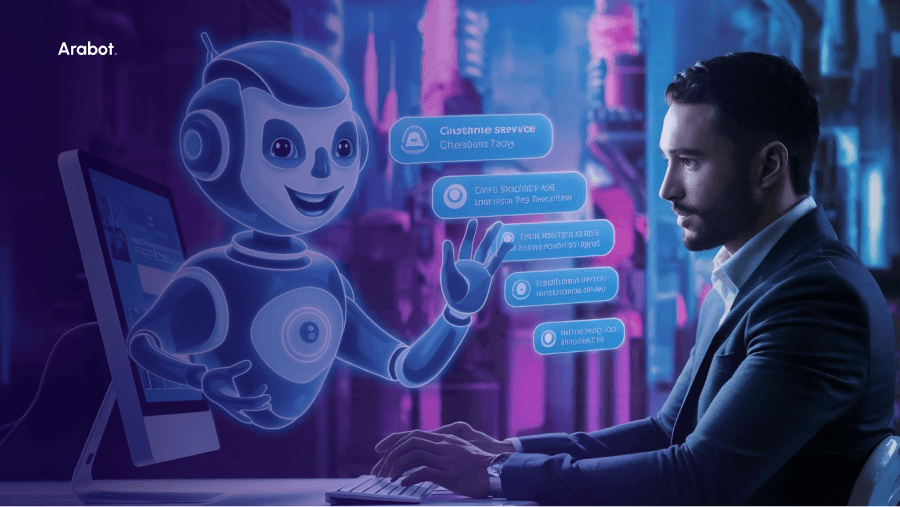Tech
Contextual AI is the future of customer service: Here's how you can use it to personalize the customer experience

In today's highly competitive business landscape, understanding and meeting customers' needs is paramount for success. As McKinsey reports, a staggering 70% of a customer's journey is based on how they feel they are being treated. Simply speaking; customer experience plays in shaping brand perception, loyalty, and ultimately, a company's bottom line.
Businesses across various industries, including banking, healthcare, and telecommunications, are recognizing the need to deliver personalized, contextual experiences that cater to their customers' unique preferences and behaviors. However, achieving this level of understanding and tailoring can be a daunting task, especially for organizations with large customer bases and complex operations.
Enter contextual AI, a cutting-edge technology that promises to revolutionize the way businesses interact with and understand their customers. By leveraging the power of natural language processing (NLP) and machine learning (ML), contextual AI enables companies to analyze customer interactions, understand the context behind their queries and actions, and provide relevant, personalized responses and experiences.
Implementing contextual AI can lead to improved customer experiences, increased customer loyalty, and ultimately, a better bottom line.
What is Contextual AI?
Contextual AI is an advanced form of artificial intelligence that goes beyond traditional AI's capabilities by incorporating contextual understanding into its decision-making processes. Unlike traditional AI systems, which rely solely on predefined rules and data patterns, contextual AI leverages natural language processing (NLP) and machine learning (ML) to comprehend the nuances and context behind human interactions.
At its core, contextual AI aims to mimic the way humans communicate and understand one another, taking into account the situational context, tone, and intent behind words and actions. This contextual awareness allows AI systems to provide more natural, human-like responses and experiences, tailored to the specific needs and preferences of individual users.
The role of NLP in contextual AI is crucial. NLP enables AI systems to analyze and interpret human language, extract meaning from text or speech, and generate appropriate responses. By combining NLP with machine learning techniques, contextual AI can continuously learn and adapt, improving its ability to understand and respond to complex human interactions over time.
While contextual AI is a relatively new concept, its roots can be traced back to the early developments in AI and NLP. However, recent advancements in computing power, data availability, and algorithm sophistication have propelled contextual AI to new heights, making it a viable and powerful solution for businesses across various industries.
Benefits of Contextual AI
Contextual AI offers a multitude of benefits for businesses operating in the banking, healthcare, and telecommunications sectors, enabling them to deliver personalized and efficient customer experiences.
Banking
Personalized financial services and recommendations
Contextual AI can analyze customers' financial data, transaction histories, and preferences to provide tailored advice on investments, savings plans, and other financial products that align with their unique goals and risk appetites.
Improved customer support for banking queries and transactions
Context-aware virtual assistants and chatbots can understand the context behind customers' queries, whether it's regarding account balances, transaction details, or loan applications. This allows for faster and more accurate resolutions, reducing frustration and improving customer satisfaction.
Fraud detection and risk management
By leveraging contextual AI, banks can monitor transactions in real-time, identifying anomalies and suspicious patterns that may indicate fraudulent activities, enabling timely intervention and minimizing financial losses.
Healthcare
Virtual assistants for medical advice and appointments
Contextual AI-powered virtual assistants can understand patients' symptoms, medical histories, and preferences to provide personalized medical advice, recommend appropriate treatments, and schedule appointments with healthcare providers.
Personalized treatment plans and medication management
By analyzing patient data, contextual AI can assist healthcare professionals in developing customized treatment plans and medication regimens tailored to individual needs and conditions, improving treatment effectiveness and reducing potential side effects.
Patient data analysis and disease prevention
Contextual AI can process vast amounts of patient data, including medical records, lifestyle information, and environmental factors, to identify risk patterns and potential health issues, enabling proactive measures for disease prevention and early intervention.
Telecom
Contextual customer support for billing, service, and technical issues
Context-aware chatbots and virtual assistants can understand customers' queries related to billing, service disruptions, or technical problems, providing personalized assistance and reducing the need for human intervention in routine matters.
Personalized product and service recommendations
By analyzing customers' usage patterns, preferences, and behaviors, contextual AI can recommend tailored telecom products, services, and bundles that best suit their needs, improving customer satisfaction and potentially increasing revenue streams.
Network optimization and predictive maintenance
Contextual AI can analyze real-time and historical network data, identifying usage patterns and potential issues, enabling predictive maintenance and network optimization, leading to improved service quality and reduced downtime.
Key Features of Contextual AI Solutions
For contextual AI solutions to effectively understand customers and provide personalized experiences, they must incorporate several key features:
1. Reading Comprehension and Document Understanding
This feature allows bots to interpret and hold conversations based on uploaded user manuals, documents, reports and papers. The bots can analyze context, entities, and relationships discussed across different text pieces to enhance understanding. It gives them broader contextual awareness beyond just structured data from databases.
2. Training Samples and Intent Recognition
By adding conversation examples as training samples, the contextual AI learns to accurately understand intents like queries, complaints etc. from the full sentence context rather than just keywords. Large sample sets related to specific topics can be imported to provide contextual examples, improving the AI's intent detection accuracy.
3. Synonym Handling
Synonym handling enables the AI to recognize references to an intent based on terms or phrases that have a similar contextual meaning, not just exact word matches. This adds flexibility, allowing the AI to understand intents based on the overall contextual meaning.
4. Variable Storage
Contextual AI solutions can store user-specific variables like location, language preferences etc. as contextual data to personalize responses. They can also remember key aspects from past conversations and use them as contextual cues.
5. API Integration
Integration with external APIs allows contextual AI bots to pull in dynamic, regularly updating contextual data from those sources to provide always-relevant responses tailored to each user's context.
6. Channel Integration
By connecting to multiple platforms like websites, mobile apps, etc., the contextual understanding is enhanced based on the unique context of how and where the conversation was initiated by the user.
Real-World Applications
The transformative potential of contextual AI is already being realized across various industries, including banking, healthcare, and telecommunications. Companies are leveraging this technology to deliver personalized, efficient, and context-aware experiences to their customers.
Healthcare
The healthcare industry is witnessing a surge in the adoption of contextual AI-powered virtual medical assistants. These AI solutions can understand patients' symptoms, medical histories, and preferences to provide personalized advice and schedule appointments.
One such example is SGH AI-powered symptom checker, which uses contextual AI to analyze patients' symptoms, medical records, and environmental factors to provide recommendations for booking.
Find out more on SGH.
Telecom
Telecommunications companies are also leveraging contextual AI to enhance their human resources operations. Context-aware chatbots can assist employees with various HR-related queries and tasks, such as leave applications, benefits inquiries, and policy clarifications. These chatbots can understand the context of the employee's query, access relevant information from HR databases, and provide personalized responses tailored to the employee's specific situation.
Find out more on Salam.
Implementing Contextual AI: Best Practices
While the benefits of contextual AI are compelling, implementing it effectively requires careful planning and execution. Here are some best practices to consider:
Data preparation
Contextual AI solutions heavily rely on high-quality data to train their models accurately. Businesses must invest time and resources into curating and preprocessing relevant data sources, such as customer interactions, product information, and domain-specific knowledge bases. This includes cleaning and structuring the data, as well as annotating it with the appropriate contextual information.
Integration
To maximize the impact of contextual AI, businesses must seamlessly integrate these solutions with their existing systems and processes. This may involve developing APIs, data pipelines, and user interfaces that enable smooth communication and data exchange between the contextual AI solution and other critical business applications, such as customer relationship management (CRM) systems, knowledge bases, and analytics platforms.
The Future of Contextual AI
The adoption of contextual AI is still in its early stages, but the potential for this technology to transform how businesses interact with and understand their customers is immense. As advancements in natural language processing, machine learning, and computational power continue, we can expect contextual AI to become even more sophisticated and ubiquitous.
Advancements in NLP and ML Technologies
Ongoing research and development in NLP and ML will enable contextual AI to achieve even deeper levels of understanding and more human-like interactions. Techniques like few-shot learning and transfer learning will allow these AI models to quickly adapt to new domains and contexts with minimal training data. Additionally, the integration of multimodal learning capabilities, which combine text, speech, and visual data, will further enhance the contextual awareness of these AI solutions.
Increasing Adoption Across Industries
While the banking, healthcare, and telecommunications sectors are already leveraging contextual AI, we can expect to see wider adoption across various other industries as well. Retail, e-commerce, travel, and hospitality are just a few examples of industries that can benefit from providing personalized, context-aware experiences to their customers. As businesses recognize the competitive advantages of contextual AI, its implementation will become a strategic imperative.
The Potential Impact on Customer Experiences and Business Growth
As contextual AI continues to evolve and become more prevalent, it has the potential to revolutionize customer experiences and drive significant business growth. By delivering highly personalized, efficient, and seamless interactions, contextual AI can foster stronger customer relationships, increase customer satisfaction, and ultimately, improve customer retention and loyalty. This, in turn, can translate into increased revenue streams, reduced operational costs, and a competitive edge for businesses that embrace this transformative technology.
While the future of contextual AI is promising, it is crucial for businesses to approach its implementation with a strategic mindset, prioritizing data privacy, ethical considerations, and continuous improvement.
Conclusion
In today's competitive business landscape, understanding and catering to customers' unique needs and preferences is paramount for success. Contextual AI emerges as a game-changing technology that enables businesses to achieve this level of personalization and customer understanding like never before.
By leveraging advanced natural language processing and machine learning capabilities, contextual AI solutions can comprehend the nuances and context behind customer interactions, preferences, and behaviors. This contextual awareness allows businesses to deliver truly personalized experiences, streamline processes, and foster stronger customer relationships.
In the ever-evolving digital landscape, businesses that embrace contextual AI and harness its power to truly understand their customers will be well-positioned to thrive and stay ahead of the curve. The time to explore and invest in contextual AI solutions is now, as the businesses that do so will reap the rewards of increased customer loyalty, improved operational efficiency, and a sustainable competitive edge.
See how arabot can help you put contextual AI to use today!
© 2016 - 2026 copyright Arabot. All rights reserved.
 Insurance
Insurance Healthcare
Healthcare Automative
Automative Hospitality
Hospitality Banking
Banking Government
Government Telecommunication
Telecommunication Education
Education Human Resources
Human Resources
